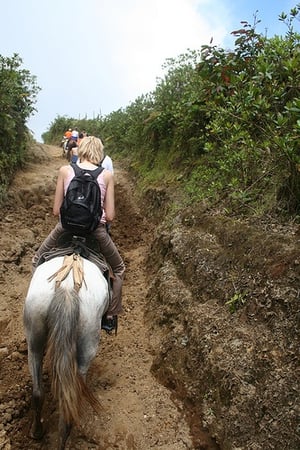Horseback Riding Injuries in the News: A 12-year-old girl suffered severe brain injuries after being thrown from a horse. The trail they had been riding on had become wet due to severe rains the night before and the horse lost its footing. Even though the girl was wearing a helmet at the time, the force from the fall was enough to cause severe damage to her skull and brain. It is likely that if she had not been wearing the helmet she would have been killed. Since the injury, the girl has gone through 14 surgeries and has slipped into a coma twice. She now requires constant care by her parents, but is slowly regaining the ability to speak and interact with others.
Statistics
- There are an estimated 30 million horseback riders in the United States
- The rate of serious injuries per riding hours is higher for horseback riders than for motorcyclists and automobile racers
- 20% of horse-related injuries happen when the rider is dismounted. These injuries typically involve the rider being kicked or stepped on by the horse.
- The most common mounted injuries involve riders being thrown or falling off the horse.
Horse Dangers
Horses are large powerful animals that are capable of tremendous speed and power. Horses often stand 6 feet tall, weigh more than 1,000 pounds, and are capable of speeds of 35 miles-per-hour.  The most common types of injuries from horses are fractures, bruises, abrasions, sprains, strains, and concussions. Injuries from horses can also occur on the ground from being stepped on or kicked by the horse. The greatest danger from horses is being thrown from a horse which can result in severe neck, spine, and head injuries.
The most common types of injuries from horses are fractures, bruises, abrasions, sprains, strains, and concussions. Injuries from horses can also occur on the ground from being stepped on or kicked by the horse. The greatest danger from horses is being thrown from a horse which can result in severe neck, spine, and head injuries.
Safe Approach
Horses are easily spooked and this is when the majority of injuries occur. Making sure all staff and riders are aware of the dangers posed by frightened horses and what actions can scare them can help prevent injuries. Some examples of things that can spook a horse include:
- Sudden or unexpected movements
- Loud, sudden noises (alarms, whistles, bells, cell phones, screams, etc.)
- Large crowds
- Other animals (for example, unleashed dogs)
- Wasps, and other insects
- Camera flashes
Safety Tips
Horseback riding is an exciting summer camp experience that many children look forward to and enjoy. While potential dangers exist due to the size, power, and unpredictable nature of horses, a few simple safety measures can ensure that horseback riding is a fun and safe activity.
- Helmets: Helmets should be worn by all riders at all times. All helmets should conform to the American Society for Testing and Materials (ASTM).
- Inspect riding areas: As seen in the story above, it is important to routinely check all areas where riding occurs to make sure there is no dangerous terrain.
- Proper saddles: Make sure all children are fitted for proper saddles. If the saddle is the improper size, the child could be more likely to slip out of it and fall.
- Proper attire: It is important all riders are equipped with appropriate rider attire and that no exceptions are made.
- Shoes should be closed toe to help protect your foot in case a horse steps on it. Shoes should also have a heel to prevent the foot from sliding through the stirrup and getting caught.
- Pants should always be worn and jeans are perfectly acceptable.
- Shirt should be tucked in.
- Gloves are also recommended to prevent the reins from slipping if hands becomes sweaty.
- Supervision: Make sure all riders are watched at all times. Staff should be trained to monitor the riders to make sure they are comfortable on the horse, obeying all the rules, and safely riding. Staff should also observe horses for signs of discomfort or if they are acting strangely.
- Training: Another crucial aspect of horseback riding safety is staff and rider training. All staff should be comfortable and experienced around horses in order to make sure they train all riders effectively. Also, before any novice rider gets on a horse they should be able to demonstrate their ability to safely ride.
Equine Liability Laws
Another important aspect of equine safety is to post your state’s equine laws in a visible, well-seen area. By keeping these laws posted you can make sure the riders are aware of the inherent dangers involved with riding horses. Posting these warning signs will also help protect your organization in the event an injury does occur. Each state has differing rules and regulations concerning the language of these signs as well as the requirements for properly displaying them. Make sure you know your state’s statutes concerning equine liability.
Waivers
Make sure all riders participating in horseback riding activity have completed and signed waivers. If the participant is under the age of 18 make sure a parent/guardian signature is obtained. It is important that these releases include the warning language contained in the posted signs.




